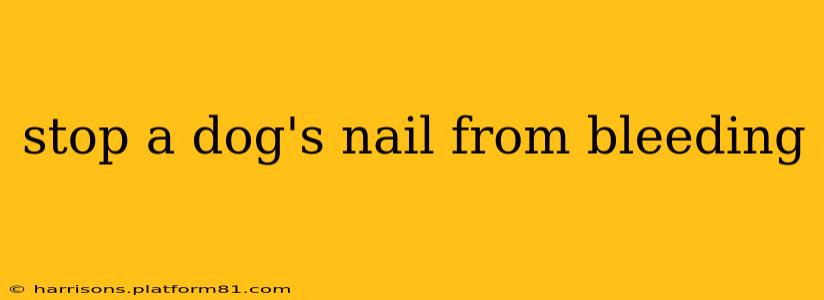Clipping your dog's nails is a necessary part of pet ownership, but accidents happen. A quick, overzealous snip can result in a bleeding nail, which can be alarming for both you and your furry friend. This guide will walk you through how to effectively stop a dog's nail from bleeding, providing you with the knowledge and confidence to handle this common situation.
What to Do if You Cut Your Dog's Nail Too Short
The first thing to remember is to stay calm. Your dog will sense your anxiety, and a calm approach will help both of you. Quickly assess the situation: how much is bleeding? Is it a steady stream or just a trickle?
The severity of the bleeding dictates your next steps. For minor bleeding, simple pressure usually suffices. For more significant bleeding, you may need more advanced techniques.
1. Apply Direct Pressure:
This is the most crucial first step. Take a clean cloth or piece of cotton and apply firm, direct pressure to the bleeding nail. Hold the pressure continuously for at least 5 minutes. This allows the blood to clot.
2. Styptic Powder:
Styptic powder is specifically designed to stop bleeding in pets. It's readily available at most pet stores and veterinary clinics. Gently apply the powder directly to the bleeding nail. The powder will help to coagulate the blood and form a clot. Follow the instructions on the packaging carefully.
3. Cornstarch or Flour (Temporary Measure):
If you don't have styptic powder on hand, cornstarch or flour can serve as a temporary measure. Apply a generous amount to the bleeding nail and hold pressure. While this isn't as effective as styptic powder, it can help slow the bleeding until you can get to a pet store or veterinary clinic.
4. Silver Nitrate Stick (Veterinary Use):
Veterinarians often use silver nitrate sticks to cauterize the bleeding nail. This should only be done by a vet or under their guidance due to the potential for causing further irritation if applied incorrectly.
When to See a Veterinarian
While most nail bleeds can be managed at home, it's crucial to seek veterinary attention in certain scenarios:
- Heavy or Uncontrollable Bleeding: If the bleeding is profuse or doesn't stop after applying pressure and styptic powder for 10-15 minutes, immediately contact your veterinarian.
- Deep Cut: If the cut is deep, you might need professional care to prevent infection.
- Signs of Infection: If you notice swelling, redness, pus, or your dog is exhibiting signs of pain or discomfort, seek immediate veterinary assistance.
How to Prevent Cutting Your Dog's Nails Too Short
Prevention is key! Here are some tips to avoid future bleeding incidents:
- Use Sharp Clippers: Dull clippers crush the nail, increasing the risk of bleeding and pain. Replace your clippers regularly.
- Good Lighting: Ensure you have ample lighting so you can clearly see the quick (the pink part of the nail containing blood vessels and nerves).
- Clip in Small Increments: It's always better to clip in small amounts, rather than taking off too much in one go. You can always clip more later.
- Get Your Dog Used to Nail Trims: Start young and make nail clipping a positive experience with treats and praise.
What is the Quick?
What is the quick in a dog's nail? The quick is the pink part of the nail containing nerves and blood vessels. Cutting into the quick is painful for your dog and causes bleeding. The quick is usually more prominent in lighter-colored nails.
How Can I Tell Where the Quick Is?
How can I tell where the quick is on my dog's nails? The quick is readily visible in light-colored nails. In dark nails, it's harder to see, so it's advisable to clip in small increments to avoid accidentally hitting the quick.
What Happens if I Cut the Quick?
What happens if I cut the quick on my dog's nails? Cutting the quick is painful for your dog and causes bleeding. The amount of bleeding can vary, ranging from a minor trickle to a significant bleed.
This information is for general guidance only and should not replace professional veterinary advice. Always consult your veterinarian with any concerns regarding your dog's health.
